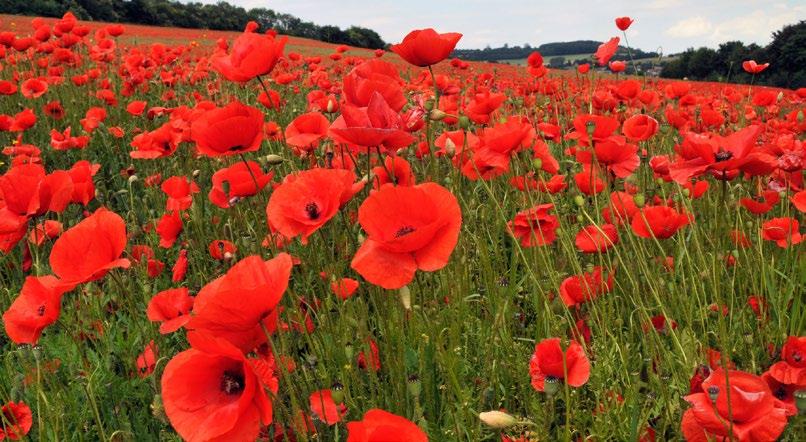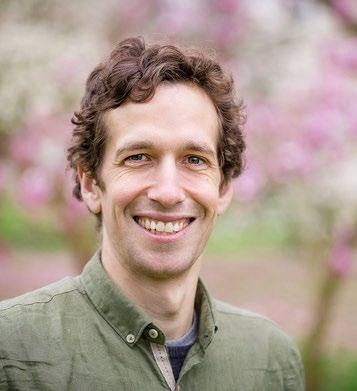
7 minute read
Outstanding in the field Tom McCarter
Outstanding in the field
Helen Vaughan interviews Tom McCarter, Wildlife Garden Manager, Natural History Museum, London
Tom’s a Kiwi, who lives and works in London – and a member of this magazine’s editorial committee. I was curious to find out what motivates him to contribute to a magazine published on the other side of the world from where he lives and works, but more intrigued about his relatively rapid career progression from a Wellington City Council garden apprentice 10 years ago to Wildlife Garden Manager at the Natural History Museum in London today.

Tom McCarter
Was horticulture your first career choice after school or did you come to horticulture after trying something else?
After finishing school I travelled, then started a Bachelor of Arts degree at Victoria University in Wellington. But after about a year and a half I realised it wasn’t for me and started to look at other options. I was interested in ‘learning while earning’, and was accepted on to several apprenticeship programmes (one of which included electrical engineering in the navy). But following my gut and some good advice, I accepted a horticulture apprenticeship with the Wellington City Council. As soon as I started I knew I’d made the right choice.
Have you always been interested in working with plants and nature?
I’ve always enjoyed nature and being outdoors. When I was growing up I was a member of a Junior Naturalists Club, which involved lots of tramping and nature talks. I knew I was interested in working outdoors, but I didn’t know horticulture was an option until later on.
As an apprentice with Wellington City Council I worked on rotation in various locations like the city parks, the botanic gardens, and nurseries. It was an excellent foundation and a great introduction to horticulture. My favourite placements were those at the botanic gardens, I enjoyed the public and plant conservation aspects.
I think there should be more support for young people to do a wider range of apprenticeships and on-the-job training as an alternative to university.
I think there should be more support for young people to do a wider range of apprenticeships and on-the-job training as an alternative to university. Was there any one person who influenced you and/or encouraged your career choices? I think I have my mum to thank for suggesting a horticultural apprenticeship! Later at Wellington Botanic Gardens I met several British horticulturists who were travelling in New Zealand on Royal Horticultural Society bursaries (one of whom I would later study the Kew Diploma with). I think they introduced me to the world of botanic gardens and encouraged me to apply to different training schemes and bursaries. They gave me the travel bug and not long after that I started to look for international opportunities, of which the most attractive was the Longwood Internship.
And how important was your time at Longwood as an intern? What did you take away from that experience?
Longwood built on my apprenticeship. During my internship I again worked in different areas on rotation, including their famous conservatories, nurseries and grounds. But it was public horticulture on a much bigger scale than I had previously seen (indeed, I still haven’t seen another 1000-bloom Chrysanthemum). There were also monthly field trips to visit other gardens on the east coast such as Chanticleer, New York Botanical Garden (NYBG), the High Line and Wave Hill.

Public horticulture magnified – the 1000-bloom Chrysanthemum at Longwood Gardens.
So the internship provided exposure to a whole range of new garden and horticultural styles. I came away from the year with a greatly expanded plant knowledge (finding wild Sanguinaria, a huge Cercidiphyllum at Chanticleer and stumbling across a Marcgravia at NYBG spring to mind), inspiration and a new appreciation for what public gardens could achieve.

And from Longwood, you went onto work and study and work at Kew...
The Longwood internship included a visit Chanticleer in Philadelphia.
Whilst living in the States, I applied for and got into the three-year Diploma of Horticulture course at Royal Botanic Gardens, Kew. It was a comprehensive education; like my previous roles it provided broad horticultural experience via rotational practical placements, but was supplemented with intense three-month academic lecture blocks, which covered subjects from botany to landscape design (and many more).
My favourite practical placements were those in the nurseries; I enjoyed propagation and was interested in plant conservation and the opportunity to work with Kew’s important plant collections. After graduating from the diploma I was fortunate to get a job in the Tropical Nursery at Kew. I moved on from there to managing the glasshouses at Chelsea Physic Garden, but was drawn back to Kew to study an MSc in plant and fungal taxonomy, diversity and conservation.
After the MSc I joined the Learning department, where I developed Kew’s first community horticulture programme. I found my time in Kew’s Learning department to be a really valuable experience, where I gained engagement skills and insight into another side of botanic gardens.
Your work appears to have been a mixture of practical horticulture and education roles. How important is education to your work as a horticulturist and more broadly to horticulture?
I think education and public engagement are central to the role of botanic gardens and museums. Botanic gardens worldwide have a platform from which to engage their local communities with plants, and also with important topics such as biodiversity loss, climate change, urban nature or GM.
I think horticulturists should be helping with education and public engagement as much as possible. In my experience, horticulture is an effective way to engage people with these big topics (other ways include art). It’s practical, tangible and helps to build scientific literacy. If you understand plants and ecosystems, hopefully you’ll understand and care about the bigger issues like climate change. We need more horticulturists and horticultural educators!
Tell me about your current position as the Wildlife Garden Manager at the Natural History Museum and the Urban Nature Project.
I manage the Wildlife Garden at the Natural History Museum (NHM) in London. The garden was established 24 years ago as a ‘living gallery’ with representations of different British habitats; there are meadows, ponds, a chalk hill, woodlands etc. My job brings together three main elements: garden management, public engagement (our staff and volunteers sit in the Learning department) and science.

The Wildlife Garden at the Natural HIstory Museum in central London.
The garden is an interesting site for the study of urban biodiversity. For the past 24 years NHM staff and scientists have been monitoring and recording biodiversity on the site. At last count there were around 3,400 species recorded – some of which are rare or scarce, and nearly all have found their own way to the garden. New species are found in the garden every year, sometimes these are new to Britain (like Cryptochetum iceryae, an Australian fly found this year) and occasionally they’re new to science. The first results from a recent environmental DNA project indicate that there are thousands more species to be discovered in the Wildlife Garden. I find it fascinating – this is in the middle of central London next to a busy road!
In the United Kingdom, there’s a growing understanding of the importance of gardens and urban sites for biodiversity (and humans), with some species actually doing better in urban areas than in the countryside. Part of my job is contributing to the Urban Nature Project, a project that will redevelop the outdoor space at the Natural History Museum, but will also coordinate a national science and engagement campaign to learn more about urban nature and engage people with its importance.
There’s been some pivotal moments on your horticulture journey – ‘sliding door’ moments. Reflecting on the past decade, since you completed your apprenticeship, what advice would you give to someone contemplating a career in horticulture?
Do it! Sign up for an apprenticeship or some other practical-learning role. But if you’re not able to commit full time (many horticulturists I know were career-changers), then consider studying with the RHS or similar and volunteering a day a week to build experience.
Apply for bursaries and scholarships and travel to see plants growing in in situ. And of course grow plants at home (and don’t be afraid to experiment or kill things)!
And in your spare time, what are you reading, watching or listening to?
It’s the 50th anniversary of the moon landings this year, and I’m enjoying listening to ’13 Minutes to the Moon’ podcast from the BBC. The last book I read was The Book of Humans by Adam Rutherford (I enjoyed it), and I’m currently I’m reading The Secret Life of Flies by Erica McAlister










